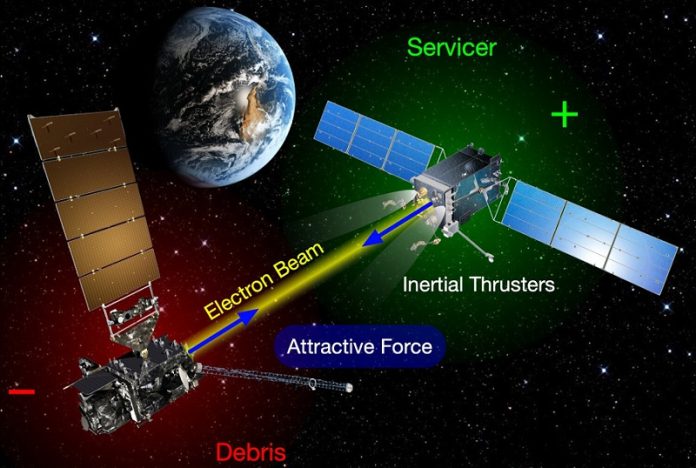
Imagine two satellites crashing into each other at incredible speeds high above the Siberian Peninsula.
That’s what happened on February 10, 2009, when a discarded Russian satellite collided with a communications satellite named Iridium 33, creating more than 1,800 pieces of debris.
While nobody was hurt, it was a wake-up call for aerospace engineers. Space was starting to feel a bit crowded.
Right now, NASA believes there are about 23,000 pieces of space junk the size of a softball or bigger spinning around our planet.
Each piece increases the risk of another crash like the one that wrecked Iridium 33, and the potential damage could be even worse next time.
Julian Hammerl, a doctoral student at CU Boulder, explains that space debris causes a domino effect. When one piece of junk hits another, it creates even more debris, leading to more chances for collisions. This is known as a cascade effect.
However, Hammerl and his team led by Professor Hanspeter Schaub have a futuristic idea to stop these chain reactions: tractor beams.
Just like in Star Trek, these beams could be used to move asteroids and other threats safely out of the way.
Here’s the idea: in the future, we could send small spacecraft into orbit to meet up with the old, non-functioning satellites circling Earth. These spacecraft, armed with devices called “electron beams,” would slowly move the debris to safety, all without needing to touch it. It’s similar to how your socks can stick to your pants because of static electricity.
Schaub, who heads the Department of Aerospace Engineering Sciences, says it’s a bit like the tractor beam from Star Trek, but not quite as powerful.
The research team still needs to overcome a few challenges, including understanding the complex environment around Earth and considering how the tractor beams could help remove debris from the region of space between Earth and the moon.
The research team is working on these problems using a special lab that can recreate space conditions. It uses a vacuum chamber to imitate the environment around Earth, filled with a thin gas of free electrons and charged atoms called plasma.
The team hopes their tractor beams can help clear up valuable space in Earth’s geosynchronous orbit, about 22,000 miles from the surface.
This region is home to some of the most high-tech satellites ever built, but it’s also getting crowded. Tractor beams could help move old satellites out of the way to make room for new ones.
The team’s “electrostatic tractor” idea is similar to rubbing a balloon on your head to make your hair stand up. A spacecraft would approach a piece of space junk and zap it with a beam of electrons.
This would create a negative charge on the junk and a positive one on the spacecraft, and since opposites attract, the spacecraft could then “tug” the debris away.
This may sound easy, but it’s quite complex. For instance, old satellites don’t just sit in one place – they can tumble wildly through space. By zapping them with pulses of electrons, the researchers believe they could slow the satellites down, making it safer to move or repair them.
Looking further ahead, the team is also considering the space between Earth and the moon, an area that is about to get a lot busier. Here, conditions are very unpredictable because of the solar wind, a stream of plasma ejected from the sun. This could affect the performance of an electrostatic tractor.
Schaub is optimistic that, with the right funding, his team could be ready to launch a prototype tractor beam into space within the next five to ten years.
He highlights that this technology could help move several objects during its lifespan, reducing costs significantly. After all, no one wants to spend billions just to move space trash.
Source: University of Colorado at Boulder.



